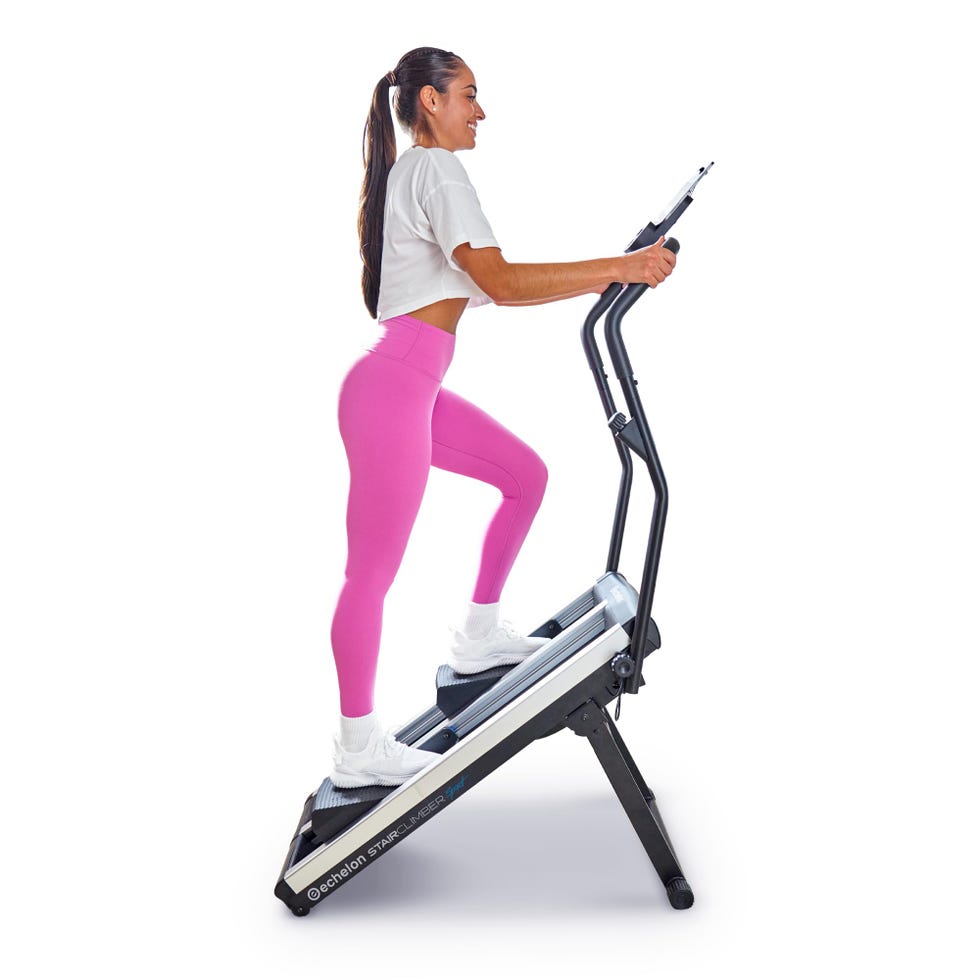Finding the perfect cardio workout can be overwhelming, especially when flashy new equipment like Peloton bikes and high-tech treadmills are everywhere you look. But if you’re looking for a workout that’s beginner-friendly, accessible, and effective for both muscle growth and weight loss, it might be time to cozy up to the humble stair stepper.
Whether you want something that’s easy on the joints or to help support your glute gains goals, stair steppers deserve your attention. This easy-to-use machine can help you crush your fitness goals, strengthening your lower body, boosting heart health, and improving overall balance, says Heather Milton, CSCS, an exercise physiologist at NYU Langone’s Sports Performance Center.
Ready to step things up? Here’s everything you need to know about stair stepper benefits—and one pro says it’s worth a spot in your cardio routine.
Meet the expert: Heather Milton, CSCS, is an exercise physiologist at NYU Langone’s Sports Performance Center.
The stair stepper is different from the StairMaster, FYI.
The aptly named stair stepper simulates the motion of climbing stairs. It’s guaranteed to get your heart rate climbing, and thanks to the adjustable resistance, you can tweak the intensity.
Unlike the StairMaster or StepMill, where the stairs actually move under your feet continuously, stair steppers feature pedals very similar to an elliptical, allowing you to step up and down in a climbing motion. This makes it a low-impact, joint-friendly cardio activity that can help with meeting a range of fitness goals, says Milton. While many gyms have at least one standard stair stepper on the floor, if you don’t have access to a stair stepper, the benefits discussed below can also be attributed to simply climbing steps IRL.
5 Stair Stepper Benefits That’ll Convince You To Try It
1. It lights up your lower body in all the right places.
If firming up your thighs or sculpting your booty is a goal of yours, this machine has you covered. The stair stepper targets your glutes, quads, and hamstrings, giving you a serious lower-body burn, and fast. Each step forces your muscles to engage through a large range of motion at the knee and hip joints, helping to tone and build strength in your butt and legs, says Milton.
2. It engages your deep core and tests your balance.
While stair climbing may be more famous for its booty benefits, your core muscles are hard at work too. To maintain your balance and keep an upright posture on the stair stepper, your deep core is forced to engage, making it an excellent way to fire up your abs and improve full-body stability, says Milton. Just make sure to not lean heavily on the handlebars; the less you rely on the handlebars for balance, the more your core has to engage to keep you stable, and the more intense and effective the workout is.
3. It’s a killer cardio workout.
In fact, it’s one of the most effective low-impact cardio exercises out there. The climbing motion elevates your heart rate quickly, boosting cardiovascular endurance and calorie burn more than many other steady-state cardio options like walking or cycling, says Milton. Studies have shown that stair climbing can improve VO2 Max, which measures how well your body uses oxygen during exercise.
That said, the StepMill is typically a more intense cardio workout than the stair stepper, Milton says. “The [StepMill] is more like climbing actual stairs…this activates more of your hip and leg muscles, resulting in a greater heart rate response.”
4. It’s easy on the joints.
If you’re dealing with joint issues or just want to avoid the wear and tear of high-impact exercises like running or jumping, the stair stepper is a great alternative. Because you’re stepping in a controlled, repetitive motion, the machine reduces the amount of impact absorbed by your knees, ankles, and hips while still providing a challenging workout, says Milton. The stair stepper is a good choice for individuals recovering from certain injuries, managing arthritis symptoms, or seeking a lower-impact cardio option that minimizes joint stress.
5. It promotes healthy, strong bones.
Stair climbing is a weight-bearing exercise (unlike, say, swimming), which is crucial for promoting healthy bone density and preventing osteoporosis as we age, says Milton. Even though it’s a low-impact activity, stair stepping does apply a light load to your bones, helping to keep them strong without applying excessive stress.
Tips For Getting Started
If you’ve never climbed onto a stair stepper before, don’t worry—it’s a pretty intuitive machine to get the hang of. For those working out at home, consider the Echelon Stair Stepper, which is designed with adjustable handlebars and non-slip pedals to support solid posture and form.
Here are a few tips to help you make the most of your stair-climbing workout:
- Start slow. If you’re a total newbie, start at a lower resistance and focus on maintaining good posture as you move slowly and with control.
- Focus on form. Keep your back straight and your core engaged, avoiding slouching. Let your legs do most of the work—try not to grip the handlebars too tightly for balance.
- Gradually increase intensity. As you get more comfortable and confident on the stepper, you can increase the resistance level little-by-little to make the workout more challenging. Interval training is a great way to do this, in which you alternate between periods of higher intensity by scaling resistance up and then back down to recover.
- Switch it up. It’s important to mix up your routine to avoid getting bored on any cardio machine. Try incorporating intervals with different resistance levels and paces to break up the workout.
Here’s a 20-minute interval workout you can try:
- Warm-up (2 minutes). Step at an easy pace, resistance level should feel like a 2 or 3 out of 10.
- Interval 1: Moderate pace (2 minutes). Increase resistance level to an effort of 5 or 6 out of 10. Maintain a steady, comfortable pace.
- Interval 2: Sprint (1 minute). Step as quickly as you can while maintaining control, up the resistance so that this feels like a 6 or 7 out of 10.
- Interval 3: Recovery (2 minutes). Slow your pace to a comfortable walk, lower resistance level to bring effort back down to a 3 or 4 out of 10.
- Interval 4: Hill climb (2 minutes). Slow your pace slightly to mimic climbing a steep hill and increase resistance to level to hit an effort of 8 to 10—this is your all-out effort!
- Repeat intervals 1-4 two more times for a total of three rounds.
- Cooldown (3 minutes). Gradually lower resistance and step at an easy pace to bring your heart rate down. This should bring your effort down to a 1 or 2 out of 10.
How The Stair Stepper Compares To Other Machines
Wondering how the stair stepper stacks up against your most-used cardio machines? Here’s a high-level comparison:
- Treadmill: Sure, the treadmill is a classic cardio workout, but the stair stepper takes the edge when it comes to strengthening your lower body. Why? The climbing motion on a stair stepper moves you through a larger range of motion with each step—especially if you crank up the resistance. This means your glutes, hamstrings, quads, and calves have to work harder, engaging more muscle power, says Milton. The climbing motion is also generally easier on the joints than running, making it a great alternative for those with knee or hip issues.
- Elliptical: Both are awesome low-impact options, but the stair stepper provides a steeper incline, which introduces more of a challenge to your lower body and core muscles, says Milton. But if you want a more full-body workout, know that the elliptical often recruits more of the upper body thanks to dynamic handlebars.
- Stationary bike: Cycling is amazing for getting your heart rate up, burning calories, and breaking a serious sweat, and because you’re seated, it’s super easy on the joints. While you can crank up the resistance to challenge your legs more, if your main goal is to strengthen your legs and core, go for the stair stepper. Cycling is still a killer cardio workout, but your core and stabilizing muscles don’t have to work as hard to support you when seated, so it doesn’t engage your muscles quite the same way as climbing stairs does, says Milton.
Talene Appleton is the fitness editor at Women’s Health, where she covers all things fitness, nutrition, and healthy living. She studied nutrition and exercise science at George Washington University and is a NASM-certified personal trainer and nutritional consultant. Passionate about the intersections between fitness, food, and community, she strives to foster inclusive and holistic wellness narratives for underrepresented populations. When not writing, she can be found hosting dinner parties and exploring new wellness and culinary experiences around New York and Los Angeles. Prior to her role at Women’s Health, she was the fitness and commerce editor at Men’s Health and contributed to General Surgery News, The Food Institute, and The Nessie.




